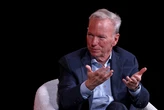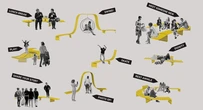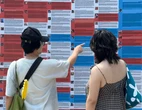In many ways, the case that sent Daniel Elie Bouaziz to prison in 2023 for money laundering felt like just another chapter in Ronnie Walker’s storied career.
Over the course of his nearly 30 years working as an undercover agent with the FBI, Walker had taken part in countless stings like this: posing as a buyer or dealer, meeting suspects in art-scented lounges or dusty storage units, working to earn their trust. He caught Warhol counterfeiters slapping fake signatures over bogus canvases. He helped recover stolen Rembrandt paintings from a Seattle-area art thief. He spent months earning the trust of Earl Marshawn Washington, the now-infamous printmaker and forger who created and sold thousands of knockoffs.
The Bouaziz case stood out only for how little effort it seemed to require. His Palm Beach gallery peddled fakes—Georgia O’Keeffe, Keith Haring, and Banksy among them—marketing inexpensive reproductions as originals, aided by bogus provenance documents and falsified signatures. His con worked well, for a while at least: Pieces could fetch prices into the tens or even hundreds of thousands.
Walker knew how that line worked. As a founding member of the FBI’s Art Crime Team, he’d gone undercover in dozens of operations. Formed in 2004 in response to the looting of Iraqi museums and growing international art trafficking, the Art Crime Team was designed as a specialized unit of agents trained in cultural property law, art history, and international smuggling.
It began with just a handful of agents—including Walker—and over time helped shape how law enforcement handled everything from Nazi-looted artworks to modern-day forgery rings. Collectively, the team has aided in the recovery of 20,000 pieces, worth in sum about $1 billion. “We’ve done a lot with a little,” says David Bass, a longtime FBI agent who helped launch the Art Crime Team alongside Walker in 2004. “Twenty agents may sound like a lot, but it’s not; it’s a very, very tiny team.”
For Walker, sometimes undercover work meant dressing like a disheveled billionaire with too much money to care; other times, it meant channeling a gallery hipster in thick glasses and a fedora. “It really comes down to the expectations of the subject on who you are; you feed their expectation to make them feel comfortable,” Walker, now 53, tells me on a Zoom call in May from his home office in the Pacific Northwest. (He keeps the location vague, explaining: “I have a few people who aren’t happy with me putting them in prison.”)
But the sheer volume of fakes in the Bouaziz case was staggering, and reinforced a growing feeling Walker had been carrying for years: that deception had become startlingly easy. It no longer required sophisticated training or access to museum archives. A motivated actor with the right gear could fabricate something convincing enough to fool collectors—or worse, enter the secondary market unchallenged. Walker came to view Bouaziz as a sort of cautionary tale, evidence that barring some kind of drastic action the art world would remain exposed to hucksters and swindlers.
As it happens, Walker’s retirement was already on the horizon. After nearly three decades in federal law enforcement, he was nearing the end. But something kept tugging at him: a notion that maybe his next act should look less like enforcement and more like protection. “I had this realization that this is a very fixable problem,” he says. “Part of the problem is technology advancements, but the solution is also technological advancement.”
And so Walker began laying the groundwork for what would become, in some sense, one of the bigger leaps in a life built on calculated setups and risky encounters: He established a nonprofit, called the Art Legacy Institute (ALI), where he now serves as president, to try to get a step ahead of the forgers. (And he wasn’t doing it alone: Bass, Walker’s former FBI colleague, retired from the bureau last month and immediately joined ALI as vice president of operations.)
The idea behind the organization is disarmingly simple: to protect artists before their work gets forged or stolen, rather than after. At the center of ALI’s tech-forward push is a partnership with the company Alitheon, whose authentication tool uses optical scanning to create a forgery-proof, touchless fingerprint for each work of art. ALI’s artist-friendly iteration of the platform will be released by the end of the year.
Another major initiative is a mobile app and website—developed in partnership with the nonprofit division of Amazon Web Services and expected to be launched later this year—that will allow artists to document their work at the moment of creation. The tool will also offer support for copyright registration and include basic scanning to help detect possible infringements online.
To a casual observer, something like a catalog might seem like a trivial indulgence. But as Walker points out, building one at that level historically has been reserved for “the smallest percentage of artists.”
They’re going after living artists
While billions of dollars pass through the legitimate art world each year, a parallel economy hums beneath the surface. According to various estimates, art crime is among the highest-grossing criminal enterprises globally, trailing only drugs and weapons trafficking.
Though it’s difficult to pin down the true scope of art forgeries—due in part to the opacity of private sales and lack of universal documentation standards—experts estimate that as much as half of the artwork in circulation may be forged or misattributed. (Theft figures are more concrete: The FBI reckons that between $4 billion and $6 billion worth of art is stolen each year, coming from private homes, galleries, religious institutions, and museums; research suggests that as little as 1.5% of that stolen work is ever recovered.)
And the forgery problem is only accelerating. Easily accessible AI models can now produce deceptively convincing works in minutes, often indistinguishable from originals to casual observers. Cheap, high-definition photography and printing allows criminals to scrupulously capture and replicate textures.
Walker has also seen a shift in those who are targeted. Increasingly, forgers aren’t focused solely on long-dead masters like Rembrandt or Rothko; they’re going after living artists, people who are still around to defend their work. On its face, that seems like a riskier move.
But with tech speeding up production and distribution, fakes can hit the market faster than experts can intervene. Meanwhile, the collectors of ultracontemporary art tend to flip pieces quickly. “They live with a piece for a brief period of time and then put it on the secondary market, often at a profit,” Walker says. That churn signals demand, and fraud tends to follow.
Consider, for instance, a hypothetical forged painting in the style of a buzzy young artist—say, someone recently featured at Frieze or Art Basel. A scammer could generate the fake using AI, print it onto canvas with a textured varnish, and list it for sale through a small online gallery or private dealer.
Given the byzantine nature of the art market, it’s entirely plausible the piece changes hands twice before anyone considers verification. By that point the original seller has long vanished, and the fake has made its way into an investment portfolio or a museum’s storage unit.
Compounding the problem, many of these transactions happen at lower price points, where scrutiny is minimal and provenance often skipped entirely. People are even gaming the legal system itself. “Counterfeiters are preemptively filing fraudulent copyrights and trademarks for items that they didn’t create,” says Daniel Lachman, founder of Justice for Artists, a digital rights group focused on intellectual property. “And a lot of times those get granted.”
Longtime Seattle gallery owner John Braseth has seen this evolution play out firsthand. “Everything is sold at auction now, primarily on the secondary market. It’s very hard to track that way,” he says. (In the past, most sales happened through galleries, where dealers often kept closer tabs on provenance and collectors.)
Online platforms make it easier than ever to sidestep scrutiny. “You can actually put anything you want up for sale and you can still have it at your house,” Braseth says. “They auction it off, and they guarantee that it’ll be delivered, what have you, and they get a nice percentage of the funds.”
“It does not fit the FBI TV profile”
It’s exactly that confluence of speed, scope, and vulnerability that Walker’s organization, ALI, was built to confront.
ALI operates as a 501(c)(3) nonprofit, backed by private fundraising. Walker says the organization has already reached about 60% of its inaugural funding goal, with the first-year target set at $500,000. The money supports everything from artist outreach to registry development and pilot programs. The nonprofit structure was intentional, Walker notes, because it helps ensure that “every decision has to be made about what’s best for the artist, not what’s best for the bottom line, not what’s best for me exiting and buying a Lamborghini.”
The scale of the challenge is daunting. But Walker, for his part, seems unfazed. When we talk over Zoom, he’s sporting a red University of Oklahoma cap and a black hoodie, silver hair peeking out from beneath the brim. (An Oklahoma native, he still carries the faint trace of an accent.) His dog dozes contentedly on the couch behind him.
Those who have spent time with Walker confirm that even in person he doesn’t exactly project federal-agent energy. “He came to visit me one day . . . hoodie on, backpack,” recalls Braseth, who collaborated with Walker a few times in the FBI days. “He looked just like a techie. It does not fit the FBI TV profile.” That understated presence, Braseth adds, is part of what makes Walker so effective: “He’s disarmingly charming and very handsome, and he is a kind person.”
These days, it helps that he’s got some cutting-edge tech on his side.
“You’re not changing the artwork”
Key to ALI’s enterprise is its partnership with Alitheon, a Bellevue, Washington-based tech company that specializes in high-fidelity optical scanning. The company’s flagship product, FeaturePrint, uses off-the-shelf cameras (including smartphone cameras) to capture the microscopic surface traits of an object and turn them into a unique numerical code.
Unlike other serialization or tracking systems, it’s touchless, meaning there’s no need for barcodes, etching, or chemical markers. For the art world, that’s essential: Altering a work, even microscopically, is taboo. “You’re not changing the artwork,” Walker says. “That is off-limits.” (ALI isn’t paying Alitheon standard enterprise rates and is essentially getting a nonprofit discount.)
Walker met Alitheon CEO Roei Ganzarski in late 2023 while still working for the FBI’s Art Crime Team. He’d heard about Alitheon’s optical authentication technology and reached out, curious but skeptical. “You’re talking to someone with trust issues,” Walker says. “I’ve seen countless gadgets offering to be these magic bullet solutions.”
After a demo from Ganzarski, Walker did what any good investigator would: He tried to break it. He checked all the patents and ran Alitheon’s software on every piece of art in his house. He even forged his own work to test its limits. Each time he came away satisfied and sold on the tech.
Founded in 2017, Alitheon now has 24 employees and backing from investors including BMW’s venture arm and IPD Capital. (Ganzarski declined to give revenue figures but said the company has been growing between 25% and 100% per year since around 2022.)
The company holds 57 issued patents and works across five high-stakes sectors: art and collectibles, luxury goods, healthcare, transportation, and defense. Ganzarski says that right away he was drawn to Walker’s mission. “Here’s a guy who’s been doing this for 30 years, who could have gone and worked for a gallery or created some profitable consulting company,” he says. “Instead, he’s taking his well-earned experience and expertise—at high risk many times—and putting it to real purpose.”
What sealed it for him, though, wasn’t just the mission—it was the man. “He’s humble, deeply knowledgeable, and honestly one of the most compelling people,” Ganzarski says, noting that they’ve had lunches that stretch on for hours, “and I don’t even notice the time passing.”
That impression tracks with those who’ve known Walker outside the job. “You don’t realize how interesting he is right away,” says artist Eric Jacobsen, who met him years ago at a painting event in Oregon. “He’s wicked funny, just very dry, and genuinely curious. He’ll sit for hours watching artists work—not saying much, just soaking it all in.”
That quiet curiosity now powers Walker’s next mission: stopping the forgeries before they even begin. He’s also working on his own budding art collection, which he proudly displays on our Zoom call, running me through a list of names like Efdot, Dennis Beall, and Shepard Fairey.
“Great art is timeless,” he says. “It speaks to every generation.”








No comments